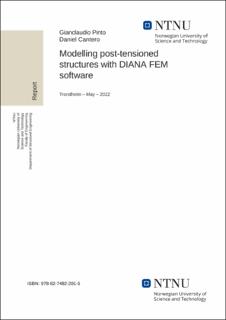| dc.description.abstract | This report aims at providing additional information and insights for the numerical analysis of damaged post-tensioned concrete in a finite element analysis framework. The study focuses on modelling the behaviour of post-tensioned structures, especially when affected by partial or complete missing grout. The work was entirely carried out using the finite element program DIANA FEA BV. The present work is a research activity related to “Bedre bruvedlikehold – DP2 Armeringskorrosjon – A4 Vedlikehold av spennarmerte konstruksjoner” (Better bridge maintenance – Corrosion – Maintenance of prestressed constructions), a project launched by the Norwegian Public Roads Administration (NPRA). The purpose of this report is to investigate and to explore how to model numerically the presence of voids in post-tensioned systems. In finite element analysis frameworks, the possibilities of completing this task, range from local analysis on the interface surrounding the post-tensioned tendon to analysis on the reinforcement itself. The DIANA software allows to investigate in such a way, giving also to the user the possibility to decide the most suitable modelling technique to define the presence of damages along a tendon. The body of this report consists in a brief introduction about the topic of the durability of post tensioned structures and its main issues and characteristics. After this preliminary overview of the topic, the case of study is presented: a simply supported beam with a parabolic-shape tendon was designed according to EC2. In the central part of the report, the beam is then investigated numerically for various voids locations and the theory behind these numerical simulations is also provided. Finally, non-linear analyses were performed to investigate both the capacity and the cracking behaviour of the differently grouted configurations | en_US |

